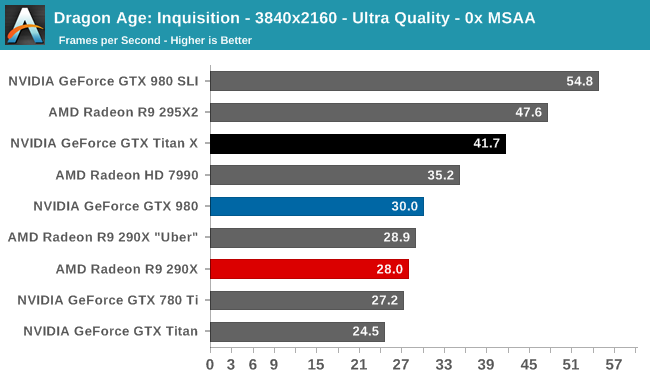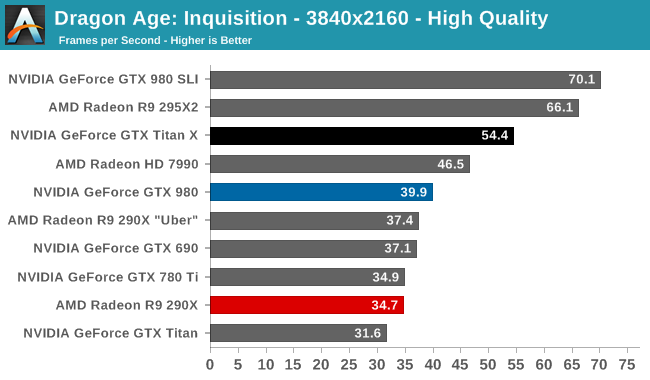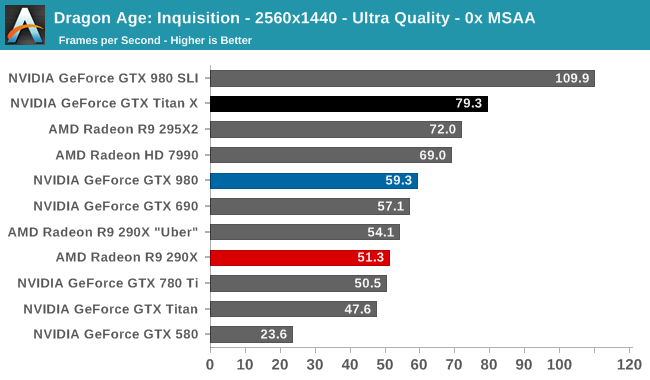The NVIDIA GeForce GTX Titan X Review
by Ryan Smith on March 17, 2015 3:00 PM ESTDragon Age: Inquisition
Our RPG of choice for 2015 is Dragon Age: Inquisition, the latest game in the Dragon Age series of ARPGs. Offering an expansive world that can easily challenge even the best of our video cards, Dragon Age also offers us an alternative take on EA/DICE’s Frostbite 3 engine, which powers this game along with Battlefield 4.



Once again turning down Frostbite’s performance-crushing MSAA, what we find at 4K with Ultra quality is that the GTX Titan X is once more hitting framerates in the 40fps range. At 41.7fps the GTX Titan X is the only single-GPU card to average better than 30fps at these settings, with the next-closest card being the GTX 980 at exactly 30fps. Overall the GTX Titan X does particularly well at 4K Ultra, beating the GTX 980 by 39%, the GTX 780 Ti by 53%, and the R9 290XU by 44%.
Users looking for higher framerates can either turn down the quality setting one notch to high, which gets us 54.4fps from the GTX Titan, or drop down to 1440p, which is good for 79.3fps. Meanwhile our multi-GPU configurations once again make their presence felt. At 4K High quality both the GTX 980 SLI are over 60fps, however the GTX Titan X unexpectedly beats the R9 295X2 at 1440p.










276 Comments
View All Comments
Dug - Thursday, March 19, 2015 - link
Thank you for pointing this out.chizow - Monday, March 23, 2015 - link
Uh, they absolutely do push 4GB, its not all for the framebuffer but they use it as a texture cache that absolutely leads to a smoother gaming experience. I've seen SoM, FC4, AC:Unity all use the entire 4GB on my 980 at 1440p Ultra settings (textures most important ofc) even without MSAA.You can optimize as much as you like but if you can keep texture buffered locally it is going to result in a better gaming experience.
And for 780Ti owners not being happy, believe what you like, but these are the folks jumping to upgrade even to 980 because that 3GB has crippled the card, especially at higher resolutions like 4K. 780Ti beats 290X in everything and every resolution, until 4K.
https://www.google.com/?gws_rd=ssl#q=780+ti+3gb+no...
FlushedBubblyJock - Thursday, April 2, 2015 - link
Funny how 3.5GB wass just recently a kickk to the insufficient groin, a gigantic and terrible lie, and worth a lawsuit due to performance issues... as 4GB was sorely needed, now 4GB isn't used....Yes 4GB isn't needed. It was just 970 seconds ago, but not now !
DominionSeraph - Tuesday, March 17, 2015 - link
You always pay extra for the privilege of owning a halo product.Nvidia already rewrote the pricing structure in the consumer's favor when they released the GTX 970 -- a card with $650 performance -- at $329. You can't complain too much that they don't give you the GTX 980 for $400. If you want above the 970 you're going to pay for it. And Nvidia has hit it out of the ballpark with the Titan X. If Nvidia brought the high end of Maxwell down in price AMD would pretty much be out of business considering they'd have to sell housefire Hawaii at $150 instead of being able to find a trickle of pity buyers at $250.
MapRef41N93W - Tuesday, March 17, 2015 - link
Maxwell architecture is not designed for FP64. Even the Quadro doesn't have it. It's one of the ways NVIDIA saved so much power on the same node.shing3232 - Tuesday, March 17, 2015 - link
I believe they could put FP64 into it if they want, but power efficiency is a good way to make ads.MapRef41N93W - Tuesday, March 17, 2015 - link
Would have required a 650mm^2 die which would have been at the limits of what can be done on TSMC 28nm node. Would have also meant a $1200 card.MapRef41N93W - Tuesday, March 17, 2015 - link
And the Quadro a $4000 card doesn't have it, so why would a $999 gaming card have it.testbug00 - Tuesday, March 17, 2015 - link
would it have? No. They could have given it FP64. Could they have given it FP64 without pushing the power and heat up a lot? Nope.the 390x silicon will be capable of over 3TFlop FP64 (the 390x probably locked to 1/8 performance, however) and will be a smaller chip than this. The price to pay will be heat and power. How much? Good question.
dragonsqrrl - Tuesday, March 17, 2015 - link
Yes, it would've required a lot more transistors and die area with Maxwell's architecture, which relies on separate fp64 and fp32 cores. Comparing the costs associated with double precision performance directly to GCN is inaccurate.